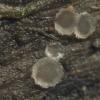
07-12-2025 16:07
Arnold BüschlenHallo, ich habe in einer Moos-Aufsammlung (epiohy

16-03-2014 22:00
Hello,I found this species a few months ago but ha

08-12-2025 13:39
Thomas Læssøehttps://svampe.databasen.org/observations/10572899

05-12-2025 17:33
 Bruno Coué
Bruno Coué
Bonjour, je serais heureux de recueillir votre avi

07-12-2025 09:24
De la pasada semana en Galicia EspañaEn el suelo

06-12-2025 00:19
 Viktorie Halasu
Viktorie Halasu
Hello, would anyone have this article, please? An
hyalinia
Alain GARDIENNET,
07-07-2008 23:08
Je n'ai pas l'habitude de ces minis petits discos alors l'avis des discophiles m'est nécessaire.
Petits discos de 0.5-0.9 mm de diamètre blancs translucides. Asques minis d'environ 25x 5 µm avec des spores filiformes en "L" de 7-10 x 0.5- 1 µm.
Pas très rosâtres pour Hyalinia rosella. est-cela néanmoins ?
Alain
Alain GARDIENNET,
07-07-2008 23:09
Perz Piotr,
07-07-2008 23:21
Re:hyalinia
Orbilia crenatomarginata Höhnel ? [=Orbilia crystallina (Quél.) Baral - NOT Orbilia crystallina Rodway]
Alain GARDIENNET,
07-07-2008 23:39
Re:hyalinia
J'ai oublié de préciser que le substrat est un vieux bout de charme (= Carpinus) pourri
Thank you Pimpek, we wait Zotto's opinion.
Alain
Thank you Pimpek, we wait Zotto's opinion.
Alain
Jean-Paul Priou,
08-07-2008 00:00

Re:hyalinia
Alain il s'agit sans aucun doute d'Orbilia crystallina (Quelet) Baral
ci-joint une vue de cette espèce publiée dnas les Cahiers nantais Priou & Poncelet
Spores courbes à helicoidales moins d'un micron de large, apothécies toujours avec de longues cellules refringentes
JPp
Merci de me donner les coordonnées stations
ci-joint une vue de cette espèce publiée dnas les Cahiers nantais Priou & Poncelet
Spores courbes à helicoidales moins d'un micron de large, apothécies toujours avec de longues cellules refringentes
JPp
Merci de me donner les coordonnées stations
Jean-Paul Priou,
08-07-2008 00:07
Alain GARDIENNET,
08-07-2008 07:22
Re:hyalinia
Bonjour Jean-Paul,
La récolte vient de :
Bourberain (21), Forêt de Velours "Etoile de la Duchesse", le 7/7/2008 sur Carpinus
Les congressistes de 2005 connaissent cette station.
Abientôt car j'ai cru voir une petite orbilia orange sur un de mes morceaux.
Alain
PS je n'ai en effet pas vu une selue spore atteignant le micron de large.
La récolte vient de :
Bourberain (21), Forêt de Velours "Etoile de la Duchesse", le 7/7/2008 sur Carpinus
Les congressistes de 2005 connaissent cette station.
Abientôt car j'ai cru voir une petite orbilia orange sur un de mes morceaux.
Alain
PS je n'ai en effet pas vu une selue spore atteignant le micron de large.
Hans-Otto Baral,
08-07-2008 11:22

Re:hyalinia
Hi Alain
I fully confirm Piotr's and Jean-Paul's correct comments. My spore measurements of nine living collections are 7-8.5(-9) x 0.6-0.9 µm. The length refers to in situ values, meaning that the real length of such helicoid spore is distinctly higher, perhaps 9-11 µm. How did you measure the spores, real length or in situ?
Here some help about the synonymy. Although crystallina is the oldest name for the fungus, my combination into Orbilia created a homonym to a Pezizalean fungus, the existence of which I was not aware. Therefore the next oldest epithet crenatomarginata must be used, because combination of crystallina into Orbilia is blocked.
O. rosella s. Boudier is a synonym, but the original concept of Fries (correct is roseola) concerns a fungus without teeth though with a puberulent margin. Possibly Fries had O. rubella or phragmotricha in hand, but this cannot be proved.
Orbilia crenatomarginata (Höhn.) Sacc. & Trotter, Syll. Fung. 22: 725 (1913)
-------------------------------------------------------------------------------------------
= Hyalinia crenatomarginata Höhn., Sitzungsber. K. Akad. Wiss. Wien, Math. Nat. Kl., Abt. I 116: 132 (1907)
= Orbilia crystallina (Quél.) Baral, Systema Ascom. 13: 120 (1994) nom. illegit. [non Orbilia crystallina Rodw., Pap. Proc. Roy. Soc. Tasmania: 114 (1920) (Pezizales)]
= Helotium crystallinum Quél., Bull. Soc. Bot. Fr. 24: 329 (1878)
= Hyalinia rosella s. Boudier (1904-10: 269, pl. 465), Grelet (1948b: 105), Moser (1963) (misspelling for roseola, nom. dub.)
Zotto
I fully confirm Piotr's and Jean-Paul's correct comments. My spore measurements of nine living collections are 7-8.5(-9) x 0.6-0.9 µm. The length refers to in situ values, meaning that the real length of such helicoid spore is distinctly higher, perhaps 9-11 µm. How did you measure the spores, real length or in situ?
Here some help about the synonymy. Although crystallina is the oldest name for the fungus, my combination into Orbilia created a homonym to a Pezizalean fungus, the existence of which I was not aware. Therefore the next oldest epithet crenatomarginata must be used, because combination of crystallina into Orbilia is blocked.
O. rosella s. Boudier is a synonym, but the original concept of Fries (correct is roseola) concerns a fungus without teeth though with a puberulent margin. Possibly Fries had O. rubella or phragmotricha in hand, but this cannot be proved.
Orbilia crenatomarginata (Höhn.) Sacc. & Trotter, Syll. Fung. 22: 725 (1913)
-------------------------------------------------------------------------------------------
= Hyalinia crenatomarginata Höhn., Sitzungsber. K. Akad. Wiss. Wien, Math. Nat. Kl., Abt. I 116: 132 (1907)
= Orbilia crystallina (Quél.) Baral, Systema Ascom. 13: 120 (1994) nom. illegit. [non Orbilia crystallina Rodw., Pap. Proc. Roy. Soc. Tasmania: 114 (1920) (Pezizales)]
= Helotium crystallinum Quél., Bull. Soc. Bot. Fr. 24: 329 (1878)
= Hyalinia rosella s. Boudier (1904-10: 269, pl. 465), Grelet (1948b: 105), Moser (1963) (misspelling for roseola, nom. dub.)
Zotto
Alain GARDIENNET,
08-07-2008 12:42
Re:hyalinia
Thank you fot these great explications.
My measures were a mixt between the two methods.
I make other mesures, but not the extrapolate (=real) measures, they give me 7-8.5 x 0.5-0.9 µm.
Amitiés,
alain
My measures were a mixt between the two methods.
I make other mesures, but not the extrapolate (=real) measures, they give me 7-8.5 x 0.5-0.9 µm.
Amitiés,
alain



